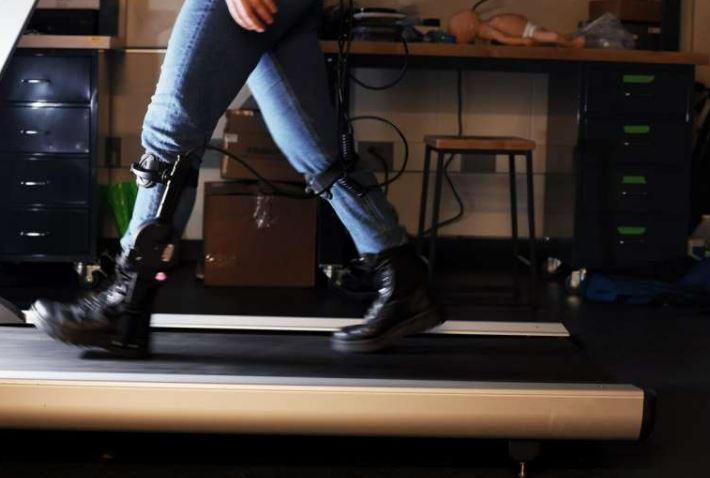

Some users rapidly regain their step when a lower limb exoskeleton malfunctions, while others overcompensate by using their ankle or hip. Brenda Ahearn of Michigan Engineering is given credit.
According to a new study by University of Michigan researchers, when lower limb exoskeletons—mechanical components worn on the leg—do not function properly, some people adjust fast while others compensate by using their ankle or hip, using more energy than is necessary.
The findings, which were published in IEEE Robotics and Automation Letters, will help create exoskeleton algorithms that are co-adaptive, meaning that the user and the exoskeleton can both learn from and adapt to one another.
Leia Stirling, an associate professor of robotics and industrial and operations engineering and a co-author of the paper, said, “Exoskeletons are a potentially very exciting technology to support mobility, but they also can create new cognitive demands and mental representations that people need to learn to use for them to be effective.”
“It’s important to understand that not everybody will respond to technology in the same way,” Stirling said.
Exoskeletons for the lower limbs must support human objectives, such as lowering walking energy consumption. Fluency is the coordinated meshing of the human and robot through the interaction of technology, cognitive decision making, and physical actions.
Exoskeletons are being built to adapt to the wearer’s walking motion and surroundings in order to increase fluency, although occasionally they make blunders. Operations may be impacted by changes in the surrounding conditions, an individual’s objectives, or the device’s perception as measured by its sensors.
Study participants without disabilities used a Dephy ExoBoot ankle exoskeleton on both legs while walking on a treadmill to evaluate how people react to exoskeleton faults. For military purposes, this concept is intended to lower muscular activation and energy expenditure. To study how accuracy affects walking behaviour, researchers designed an exoskeleton control algorithm with five distinct fixed error rates up to 10% mistake, or 90% accuracy.
The researchers evaluated the gait patterns of subjects when the exoskeleton functioned as intended and when it malfunctioned, failing to actuate at the appropriate moment during a step, by means of a motion capture camera system.
Study participants without disabilities used a Dephy ExoBoot ankle exoskeleton on both legs while walking on a treadmill to evaluate how people react to exoskeleton faults. For military purposes, this concept is intended to lower muscular activation and energy expenditure. To study how accuracy affects walking behaviour, researchers designed an exoskeleton control algorithm with five distinct fixed error rates up to 10% mistake, or 90% accuracy.
The researchers evaluated the gait patterns of subjects when the exoskeleton functioned as intended and when it malfunctioned, failing to actuate at the appropriate moment during a step, by means of a motion capture camera system be meeting the goals,” said Stirling.
While the purpose of this specific design was to improve endurance in individuals without disabilities, exoskeletons that facilitate walking could benefit those who are limited in their movement due to age, illness, or accident.
Investigating the relationship between humans and exoskeletons can help with the creation of exoskeleton algorithms that will enable future users’ natural walking gaits.



